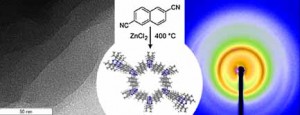Bojdys,* M. J.; Jeromenok, J.; Thomas, A.; Antonietti, M. Advanced Materials 2010, 22, 2202-2205.
A layered, covalent, triazine-based framework (CTF) was synthesized via the condensation of 2,6-naphthalenedicarbonitrile under ionothermal conditions. The polytrimerization of this bi functional carbon nitrile in zinc chloride at lower temperatures yields a well-ordered, close-packed framework. At elevated temperatures an amorphous, yet porous solid is obtained, which shows remarkable thermal stability (640 °C) and a high surface area (2255 m2 g−1 and 1.51 cm3 g−1).
DOI: 10.1002/adma.200903436 [Download]
This is the pre-peer reviewed version of the following article: Bojdys, M. J.; Jeromenok, J.; Thomas, A.; Antonietti, M. Advanced Materials 2010, 22, 2202-2205, which has been published in final form at [DOI: 10.1002/adma.200903436].


